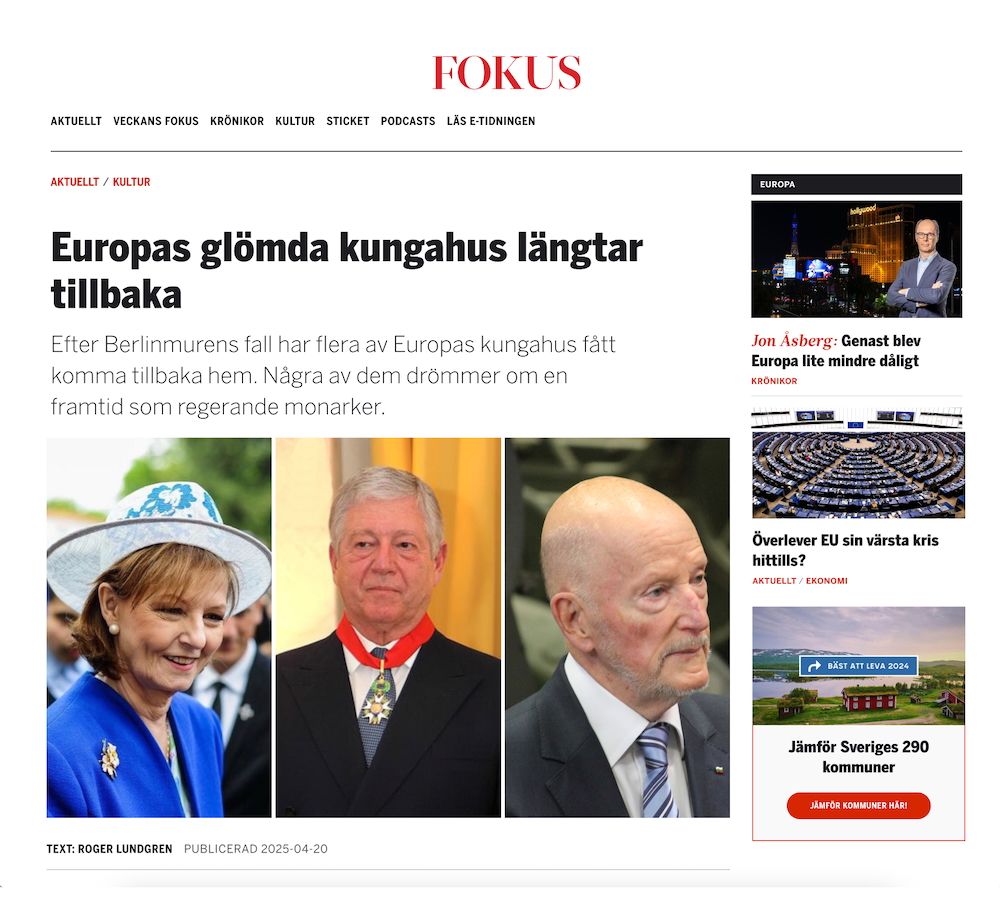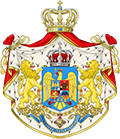Despre Coroana Română în presa suedeză, 2025
Recent, în presa suedeză a apărut acest articol, dedicat Coroanei Române și Caselor Regale din Europa de Sud-Est. Articolul este semnat de jurnalistul Roger Lundgren și a fost publicat în revista Fokus în aprilie 2025. Vă prezentăm mai jos articolul în original, iar apoi traducerea în limba engleză.







Roger Lundgren, 20 April 2025
After the fall of the Berlin Wall, several of Europe’s royal houses have been allowed to return home. Several of them dream of a future as reigning monarchs.
When the Swedish royal family hosts a party, royals from countries like Greece, Serbia, Romania and Bulgaria are often seen among the guests, even though these countries have not been monarchies for half a century or more. The reason they are still referred to by their historical titles is a principle that has been in use since the Peace of Westphalia in 1648. Once royal – always royal, regardless of whether one has sat on a throne or not.
In most of Europe’s republics, relations with the former royal houses have been frosty – not least in Greece, where the monarchy was abolished in 1974. There, the royal family’s citizenship was revoked, their property was confiscated and they were forced to leave the country. However, the last king of Greece, Constantine II, took his homeland to the European Court of Justice, which ruled in the king’s favor in 2000. Some time ago, Constantine’s children and several grandchildren applied for Greek citizenship, which they all received with the surname „de Grèce”. However, they had to swear an oath of allegiance to the constitution of the Hellenic Republic. Constantine himself died in 2023, at the age of 83.
In Italy, the male descendants of the country’s last king, Umberto II, were granted entry into the country as late as 2002 after a change in the law pushed through by then-Prime Minister Silvio Berlusconi. The reason the Italian princes were not allowed to set foot on Italian soil was that the Italians chose to abolish the monarchy in a referendum in 1946, immediately after World War II. The Austrians also had a strained relationship with the Habsburg imperial court, which abdicated and left the country after its defeat in World War I. It was only after about 60 years, in the late seventies, that contacts with the Habsburgs were normalized.
After the fall of the Berlin Wall in 1989, many of the Eastern European royal houses breathed the morning air. None of them could have imagined that they would be able to return to their homelands, not least because of the propaganda that the communist dictatorships had spread about the families. The dynasty that today has the greatest influence in the old Eastern Bloc is the Romanian royal house. The country’s last king, Michael I, ruled his country twice, first as a child between 1927 and 1930, then between 1940 and 1947, when the communists forced him to abdicate. He fled to Switzerland, married, had five daughters and worked for many years as a farmer and test pilot to support his large family. The family fortune remained in Romania. After the revolution against the communist dictatorship in December 1989, he tried to return to Romania. He managed to visit the country once, but was rejected by the country’s new leaders, who were concerned about the king’s enormous popularity. Fifty years after Michael was forced to leave his homeland, he finally regained his Romanian citizenship and several properties that belonged to his family. When the king died in 2017, the Romanian nation organized a state funeral with invited guests from all over the world, including the Swedish royal couple and the then Prince of Wales, now King Charles III. Hundreds of thousands of Romanians followed the funeral procession through the streets of Bucharest. After the king’s death, his eldest daughter Margareta, born in 1949, is the family’s main representative. She is styled „Your Majesty” and bears the title „Custodian of the Romanian Crown”. Together with her husband, Prince Radu, she carries out a large number of official missions each year. She travels around Romania in the same royal train her ancestors used, maintains the royal order, holds an annual diplomatic reception in the old palace, and visits other countries as a representative of Romania. All of this she does in close cooperation with the Romanian Government.
– For me and my family, it is important to be able to contribute to our country in different ways and many times we do it in parallel with the president and the government. There are no contradictions between us, rather a common aspiration for the good of Romania, she tells Fokus. – Romania is a republic but has a functioning royal house. We have a court with competent employees and most of our tasks are similar to the tasks of my relatives in the ruling royal houses.
In connection with King Michael’s funeral, an opinion poll showed that 37 percent of the Romanian people would like to see the monarchy as a form of government with an apolitical monarch as head of state, just like the Swedish model. The position of the Romanian royal family can be described as unique. When Michael returned, the Romanian state handed over the right to dispose of the Elisabeta Castle in Bucharest, the fairytale Peles Castle in Sinaia and a large amount of land to the ex-king, and parliament has discussed giving the royal family an appanage. In Serbia, too, the government has returned the royal palace to Crown Prince Alexander, born in 1945. He is the son of Yugoslavia’s last king, Peter II. For many years, the palace, which was built by the royal family, was the residence of Yugoslavia’s communist leader Josip Broz Tito and later of Serbia’s president Slobodan Milošević. Today, contacts between the Crown Prince and the Serbian state are good, and when he travels around the world, he is looked after by Serbian missions. Europe’s only living ex-king is the 87-year-old Simeon of Bulgaria, who was his country’s monarch from the age of six until the monarchy was abolished by the communists in 1946. Simeon was forced to take over the crown as a child after his father, Boris III, died suddenly after a meeting with Adolf Hitler in Berlin. King Boris stood up for the Jewish population of his kingdom during World War II, which was not appreciated by the Nazis. Several historians have claimed over the years that the king was poisoned in Berlin. Simeon, of course, never ruled his country himself, but had a guardian government and was forced to flee Bulgaria after the war. He ended up in Madrid, where he lived for many years and supported himself as a businessman. He has long had close contact with the Swedish royal family, as he comes from the same family as King Carl XVI Gustaf’s mother, Princess Sibylla of Saxe-Coburg and Gotha, and has been a good friend of our king since his youth. Simeon was given back the family castle of Vrana outside Sofia in 1999, and although he did not become Bulgaria’s reigning king again, he was elected prime minister in 2001. He held that position until 2005 under the name Simeon Saxe-Coburg. Many Bulgarians saw the king as a savior, and when he ran for office with the newly formed party National Movement Simeon II, he received half of the seats in parliament and was thus able to form a government.
– I had a longing to be able to do something concrete for my country and when I got the opportunity to run for the post of Prime Minister, I did it. Those were tough years, with a lot of work and little sleep, but we achieved several successes such as membership in NATO and negotiations that led to us becoming part of the EU in 2007, he tells Fokus. A couple of elections later, Simeon’s party was almost wiped out and today he lives a quiet life with his wife Margarita. They divide their time between the castle outside Sofia and the couple’s old home in Madrid. Regarding the future of the monarchy, he says this: – Of course, my family and I are ready to serve Bulgaria if the people want to restore the monarchy, but it is a decision that they have to make.
In 2015, the king’s eldest son and heir Kardam died after a tragic car accident and his son Boris is now Simeon’s heir. – I think the Romanian solution with Margareta’s title has been very good, so my hope is that my grandson will call himself the guardian of the crown the day I am no longer here, because even though Bulgaria is a republic, it is important that our family history can live on, says Simeon II.
